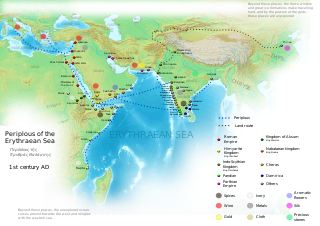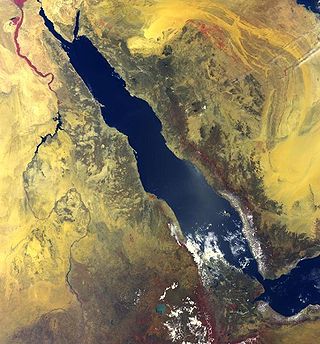
Proto-Somalis were the ancient people and ancestors of Somalis who lived in present-day Somalia. [1] Literature on proto-Somalis largely uses a time-frame pertaining to the 1st millennium BC and 1st millennium AD. [2]

Proto-Somalis were the ancient people and ancestors of Somalis who lived in present-day Somalia. [1] Literature on proto-Somalis largely uses a time-frame pertaining to the 1st millennium BC and 1st millennium AD. [2]
The Puntites were ancient Cushites who are believed to have traded myrrh, spices, gold, ebony, short-horned cattle, ivory, and frankincense with neighbouring Ancient Egypt and with ancient Mesopotamia through their commercial ports. An Ancient Egyptian expedition sent to Punt by the 18th dynasty Queen Hatshepsut is recorded on the temple reliefs at Deir el-Bahari, during the reign of the Puntite King Parahu and Queen Ati. [3]
In the classical era, the Macrobians, who have been ancestral to the Automoli or ancient Somalis, established a powerful tribal kingdom that ruled large parts of modern Somalia. They were reputed for their longevity and wealth and were said to be the "tallest and handsomest of all men." [4] The Macrobians were warrior herders and seafarers. According to Herodotus' account, the Persian Emperor Cambyses II, upon his conquest of Egypt (525 BC), sent ambassadors to Macrobia, bringing luxury gifts for the Macrobian king to entice his submission. The Macrobian ruler, who was elected based on his stature and beauty, replied instead with a challenge for his Persian counterpart in the form of an unstrung bow: if the Persians could manage to draw it, they would have the right to invade his country; but until then, they should thank the gods that the Macrobians never decided to invade their empire. [4] [5] The Macrobians were a regional power reputed for their advanced architecture and gold wealth, which was so plentiful that they shackled their prisoners in golden chains. [5] The Harla is an extinct people credited for building various monuments in the Horn Africa are possible candidates of Proto-Somali. [6]
After the collapse of Macrobia, several proto-Somali ancient wealthy city-states emerged, such as Malao, Mundus, Mosylon and, Opone, which competed with the Sabaeans, Parthians, and Axumites for the wealthy Indo-Greco-Roman trade also flourished in Somalia. [7] Somali sailors and merchants were the main suppliers of gold, silver, gemstones, frankincense, myrrh, acacia gum, salt, livestock, ivory, feathers, hide (skin), and spices, items that were considered valuable luxuries.
Other notable proto-Somali city-states included Avalite, Bulhar, Botiala, Essina, Damo, Hannassa, Sarapion, Nikon, Toniki, Gondal, Macajilayn, Salweyn, and Miandi. Ancient Greek travelers including the likes of Strabo and Cosmas Indicopleustes made visits to the Somali peninsula between the 1st and 5th century. The Greeks referred to Somalis as the Barbaria and their land as Barbars. [8]
In Somalis, the Time to Most Recent Common Ancestor (TMRCA) was estimated to be 4000–5000 years (2,500 BCE) for the haplogroup E-M78 cluster γ and 2100–2200 years (150 BCE) for Somali T-M184 bearers. [9]
Deep subclade E-Y18629 is commonly found in Somalis and has a formation date of 3,600 YBP (years before present) and a TMRCA of 2,600 YBP. [10]
There were many examples of proto-Somali states. Some of these include:
The year 525 BC was a year of the pre-Julian Roman calendar. In the Roman Empire, it was known as year 229 Ab urbe condita. The denomination 525 BC for this year has been used since the early medieval period, when the Anno Domini calendar era became the prevalent method in Europe for naming years.

Myrrh is a gum-resin extracted from a few small, thorny tree species of the Commiphora genus, belonging to the Burseraceae family. Myrrh resin has been used throughout history in medicine, perfumery, and incenses. Myrrh mixed with posca or wine was widely used in many ancient cultures to produce pleasurable feelings and as an anti-inflammatory and analgesic.

The Medes were an ancient Iranian people who spoke the Median language and who inhabited an area known as Media between western and northern Iran. Around the 11th century BC, they occupied the mountainous region of northwestern Iran and the northeastern and eastern region of Mesopotamia in the vicinity of Ecbatana. Their consolidation in Iran is believed to have occurred during the 8th century BC. In the 7th century BC, all of western Iran and some other territories were under Median rule, but their precise geographic extent remains unknown.

Frankincense, also known as olibanum, is an aromatic resin used in incense and perfumes, obtained from trees of the genus Boswellia in the family Burseraceae. The word is from Old French franc encens. There are several species of Boswellia that produce true frankincense: Boswellia sacra, B. frereana, B. serrata, and B. papyrifera. Resin from each is available in various grades, which depends on the time of harvesting. The resin is hand-sorted for quality.

Hafun is a town in the northeastern Bari province of Somalia. Situated in Ras Hafun on the coast of the Guardafui Channel, it is the centre of the Hafun District, and the easternmost town in continental Africa. It is an ancient town previously known as Opone.

Opone was an ancient seaport and emporium located in present-day Somalia. It is primarily known for its trade with the Ancient Egyptians, Romans, Greeks, Persians, and the states of ancient India. The historic port has been identified with the city of Hafun through archaeological remains. It is possible that it corresponds to the Land of Punt as known by the ancient Egyptians during the Old, Middle, and New Kingdom.

The Somali people are a Cushitic ethnic group native to the Horn of Africa who share a common ancestry, culture and history. The East Cushitic Somali language is the shared mother tongue of ethnic Somalis, which is part of the Cushitic branch of the Afroasiatic language family. They are predominantly Sunni Muslim. Forming one of the largest ethnic groups on the continent, they cover one of the most expansive landmasses by a single ethnic group in Africa.

The incense trade route was an ancient network of major land and sea trading routes linking the Mediterranean world with eastern and southern sources of incense, spices and other luxury goods, stretching from Mediterranean ports across the Levant and Egypt through Northern East Africa and Arabia to India and beyond. These routes collectively served as channels for the trading of goods such as Arabian frankincense and myrrh; Indian spices, precious stones, pearls, ebony, silk and fine textiles; and from the Horn of Africa, rare woods, feathers, animal skins, Somali frankincense, gold, and slaves. The incense land trade from South Arabia to the Mediterranean flourished between roughly the 3rd century BC and the 2nd century AD.

The history of Somaliland, a country in the eastern Horn of Africa bordered by the Gulf of Aden, and the East African land mass, begins with human habitation tens of thousands of years ago. It includes the civilizations of Punt, the Ottomans, and colonial influences from Europe and the Middle East.

Pre-Islamic Arabia refers to the Arabian Peninsula prior to the rise of Islam. In Islamic tradition, this period is called the Jahiliyyah.

The Land of Punt (Egyptian: pwnt; alternate Egyptological readings Pwene(t) ) was an ancient kingdom known from Ancient Egyptian trade records. It produced and exported gold, aromatic resins, blackwood, ebony, ivory and wild animals. Recent evidence locates it in northwestern Eritrea. It is possible that it includes or corresponds to Opone, as later known by the ancient Greeks, while some biblical scholars have identified it with the biblical land of Put or Havilah.

The Qedarites were an ancient Arab tribal confederation centred in their capital Dumat al-Jandal in the present-day Saudi Arabian province of Al-Jawf. Attested from the 9th century BC, the Qedarites formed a powerful polity which expanded its territory throughout the 9th to 7th centuries BC to cover a large area in northern Arabia stretching from Transjordan in the west to the western borders of Babylonia in the east, before later consolidating into a kingdom that stretched from the eastern limits of the Nile Delta in the west till Transjordan in the east and covered much of southern Judea, the Negev and the Sinai Peninsula.

Maritime history of Somalia refers to the seafaring tradition of the Somali people. It includes various stages of Somali navigational technology, shipbuilding and design, as well as the history of the Somali port cities. It also covers the historical sea routes taken by Somali sailors which sustained the commercial enterprises of the historical Somali kingdoms and empires, in addition to the contemporary maritime culture of Somalia.

The Macrobians (Μακροβίοι) were a legendary people and kingdom positioned in the Horn of Africa mentioned by Herodotus. It is one of the peoples postulated by the Greeks to exist at the extremity of the known world, in this case in the extreme south, contrasting with the Hyperboreans in the extreme north.
Ancient Egyptian trade developed with the gradual creation of land and sea trade routes connecting the ancient Egyptian civilization with ancient India, the Fertile Crescent, Arabia and Sub-Saharan Africa.

Somali nationalism is a nationalist ideology advocating for the unification of all Somali people who share a common ethnicity, language, and culture, under a single banner. Its earliest manifestations has its roots in the Middle Ages with the Adal Sultanate and the Ajuran Sultanate whilst in the contemporary era its often traced back to the “Mad Mullah”, as he was known by the British Empire during the Scramble for Africa. The Somali Youth League, a political organisation founded in 1943 was one of the most influential political parties in Somalia prior to the country’s unification and independence. The Somali guerrilla militia Al-Shabab is noteworthy for incorporating Somali nationalism into its Islamist ideology.

The history of spices reach back thousands of years, dating back to the 8th century B.C. Spices are widely known to be developed and discovered in Asian civilizations. Spices have been used in a variety of antique developments for their unique qualities. There were a variety of spices that were used for common purposes across the ancient world. Different spices hold a value that can create a variety of products designed to enhance or suppress certain taste and/or sensations. Spices were also associated with certain rituals to perpetuate a superstition or fulfill a religious obligation, among other things.

In antiquity, the ancestors of the Somali people were an important link in the Horn of Africa connecting the region's commerce with the rest of the ancient world. Somali sailors and merchants were the main suppliers of frankincense, myrrh and spices, items which were considered valuable luxuries by the Ancient Egyptians, Phoenicians, Mycenaeans and Babylonians. During the classical era, several ancient city-states competed with the Sabaeans, Parthians and Axumites for the wealthy Indo-Greco-Roman trade.
The ancient history of Africa spans from the ancient period until the medieval and early modern period in the history of Africa.
{{cite book}}: |first= has generic name (help){{cite book}}: CS1 maint: location missing publisher (link)